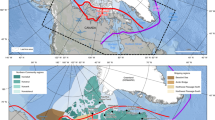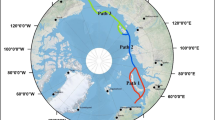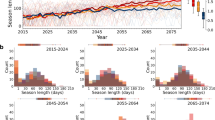Abstract
There is wide recognition that the process of climate change may be affecting the Arctic region at a faster pace than other regions. What is uncertain is the full impact of climate change on ice cover, and in particular whether there will be a significant decrease of summer ice from the current three months to a longer period and accompanied by navigation conditions suitable and safe for commercial shipping. New international navigation routes through the Canadian and Russian Arctic sectors could significantly reduce the length of sea voyages from Asia to North America and Europe. However, on the basis of what is known to date, there are significant differences of view as to the feasibility of international commercial navigation in the Northwest Passage.
If Arctic change occurs on a scale sufficient to permit international commercial navigation, it would be useful for polar states, the maritime industry and the IMO to anticipate the significance and limitations of new Arctic sea routes. Major constraints include the special sensitivity of the Arctic marine environment which would certainly necessitate the need for very high environmental standards for ships, in addition to the IMO Guide lines for Ships Operating in Arctic Ice-covered Waters. Arctic states can draw upon UNCLOS Article 234 on ice covered areas, potential MARPOL 73/78 special area and PSSA designation utilizing various measures under SOLAS to raise standards. The infrastructure of navigational services for commercial shipping would need to be upgraded, in particular navigation aids, search and rescue and contingency planning and response to environmental incidents and casualties.
A significant consideration in the context of such change is likely to be Canada’s sovereignty claim over the waters of the Northwest Passage. Also, any action in the Arctic will need to take heed of the Arctic Council and the views and interests of the indigenous peoples of the North. In this regard, some preliminary work has commenced with the Arctic Marine Shipping Assessment.
The paper concludes with issues for consideration at the 2008 Conference on the Impact of Climate Change on the Maritime Industry.
Similar content being viewed by others
References
Adam, D. Global warming sparks a scramble for black gold under retreating ice.The Guardian, 18 April 2006.
Arctic Climate Impact Assessment (ACIA). 2004.Impacts of a Warming Arctic: Arctic Climate Impact Assessment. New York: Cambridge University Press.
Arctic Council. 1991. Arctic Environment Protection Strategy June 14, 1991. http://www.arctic-council.org/Archives/AEPS%20Docs/artic_environment.pdf
---. 2004a. Arctic Marine Strategic Plan November 24, 2004. http://arcticportal. org/uploads/vx/IW/vxIWcyCi_7UnSBwZDbPVug/AMSP-Nov-2004.pdf
---. 2004b. Guidelines for Transfer of Refined Oil and Oil products in Arctic Waters (TROOP) November 2004. http://old.pame.is/sidur/uploads/TROOP%20–%20 English %202.pdf
---. 2006. Arctic Marine Shipping Assessment: The Arctic Council’s Response to Chang ing Marine Access. PAME Progress Report, October 2006.
AWPPA. 1970. Arctic Waters Pollution Prevention Act. Revised Statutes of Canada 1985, c. A-12.
Brigham, L.W. n.d. Changing Marine Access in the Arctic Ocean — A Strategic View for the 21st Century.Arctic Climate Impact Assessment (ACIA) Symposium Extended Abstract. http://www.arctic.noaa.gov/detect/human-access-arctic.shtml.
Chircop, A. and S. Rolston, eds. 1987.Canadian Arctic Sovereignty. International Insights Occasional Publication No. 1. Halifax: Dalhousie University.
Christensen, J.H., B. Hewitson, A. Busuioc, A. Chen, X. Gao, I. Held, R. Jones, R.K. Kolli, W.-T. Kwon, R. Laprise, V. Magaña Rueda, L. Mearns, C.G. Menéndez, J. Räisänen, A. Rinke, A. Sarr and P. Whetton. 2007. Regional Climate Projections. In:Climate Change 2007: The Physical Science Basis. Contribution of Working Group I to the Fourth Assessment Report of the Intergovernmental Panel on Climate Change. ed. Solomon, S., D. Qin, M. Manning, Z. Chen, M. Marquis, K.B. Averyt, M. Tignor and H.L. Miller. New York: Cambridge University Press.
Company of Master Mariners of Canada. 2007. Review of the Seminar “Canadian Arctic Issues in a Changing Climate,” organized by the Company of Master Mariners of Canada (CMMC) in conjunction with the Marine Affairs Program of Dalhousie University and Lloyd’s register, North America, December 2006 (revised January 2007).
Gold, E., J.A. Cantello & P.L. Wright. 1997. Marine Insurance for the Northern Sea Route: The Feasibility of a New Risk Regime: Some Initial Conclusions. INSROP Working Paper 85–1997. International Northern Sea Route Programme. Gold, E. 2004. Marine Risk Management for the Northern Sea Route-Marine Insurance Coverage for Oil and LNG Tankers. Interim Report — May 2004, Arctic Operational Platform Sub-Project: WP 2.4. Fridtjof Nansen Institute, Oslo. http://www. arcop.fi/reports/D241.pdf
Griffiths, F., ed. 1987.Politics of the Northwest Passage. Kingston: McGill-Queens University press.
———. 2005. New Illusions for a Northwest Passage. InInternational Energy Policy, the Arctic and the Law of the Sea, ed. M. H. Nordquist, J. N. Moore and A. S. Skaridov, 303–319. Leiden: Martinus Nijhoff Publishers.
Huebert, R. 2001. Climate Change and Canadian Sovereignty in the Northwest Passage.ISUMA 2, no.4. http://www.isuma.net/v02n04/huebert/huebert_e.pdf.
International Association of Classification Societies (IACS). 2007. Requirements Concerning Polar Class. IACS Req.2007. http://www.iacs.org.uk/document/public/ Publications/ Unified_requirements/PDF/UR_I_pdf410.pdf.
International Convention for the Prevention of Pollution from Ships, 1973, as modified by the Protocol of 1978 relating thereto. (MARPOL 73/78). London, 17 February 1978, 1340 UNTS 62–265 (1983).
International Maritime Organization (IMO). 2002. Guidelines for Ships Operating in Arctic Ice-Covered Waters. MSC/Circ.1056, MEPC/Circ. 399, 23 December 2002.
---. 2006. Revised Guidelines for the Identification and Designation of Particularly Sensitive Sea Areas, adopted by Resolution A.982(24) on 1 December 2005. A 24/ Res. 982, 6 February 2006.
Jakobsson, T. E. 2005. Climate Change and the Northern Sea Route: An Icelandic Perspective. InInternational Energy Policy, the Arctic and the Law of the Sea, ed. M. H. Nordquist, J. N. Moore and A. S. Skaridov, 285–301. Leiden: Martinus Nijhoff Publishers.
Newton, G.B. 2005. Coming to the Arctic: Oil, Ships and UNCLOS Plus. InInternational Energy Policy, the Arctic and the Law of the Sea, ed. M. H. Nordquist, J. N. Moore and A. S. Skaridov, 321–335. Leiden: Martinus Nijhoff Publishers.
Nordquist, M.H., Yankov, A., Grandy, N.R. and Rosenne, S. 1991.United Nations Convention on the Law of the Sea 1982: A Commentary. vol. IV, 392–398. Dordrecht: Martinus Nijhoff Publishers.
Office of Naval Research, Naval Ice Center, Oceanographer of the Navy and The Arctic Research Commission. 2001. Naval Operations in an Ice-Free Arctic. Symposium 17–18 April 2001. Final Report. Arlington, VA: US Office for Naval Research.
United Nations Convention on the Law of the Sea. Montego Bay, December 10, 1982. A/CONF.62/122, October 7, 1982.
United States Arctic Research Commission (USARC). n.d. The Arctic Ocean and Climate Change: A Scenario for the US Navy. Arlington, VA.: USARC.
United States Department of State, Bureau of Oceans and International Environmental and Scientific Affairs. 1992. Limits in the Seas no. 112: United States Responses to Excessive Maritime Claims. Washington D.C.: US Dept. of State, 9 March 1992.
VanderZwaag, D.L. and C. Lamson, eds. 1990.The Challenge of Arctic Shipping Science, Environmental Assessment, and Human Values. Kingston: Mc-Gill Queens University Press.
Wilkins, T. 2007. Effects of Climate Change on Shipping. Presentation, ICCMI2008 — Preparatory Workshop, World Maritime University, Malmö, June 7–8, 2007.
Wilson, K.J., J. Falkingham, H. Melling and R. De Abreu. 2004. Shipping in the Canadian Arctic: Other Possible Climate Change Scenarios.Geoscience and Remote Sensing Symposium,IGARSS ’04, 20–24 Sept. 2004, Anchorage, Alaska. Proceedings, vol. 3, 1853–1856. New York, NY: IEEE International.
Author information
Authors and Affiliations
Corresponding author
Rights and permissions
About this article
Cite this article
Chircop, A. Climate change and the prospects of increased navigation in the Canadian Arctic. WMU J Marit Affairs 6, 193–205 (2007). https://doi.org/10.1007/BF03195114
Issue Date:
DOI: https://doi.org/10.1007/BF03195114




